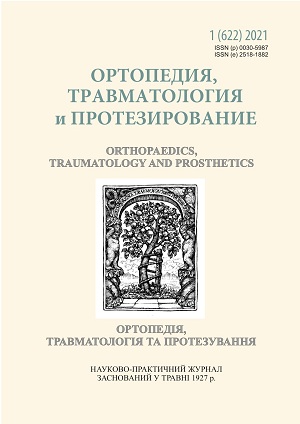Treatment of patients with complicated fractures of the distal humerus using the fixators of limited-contact multiplanar osteosynthesis
DOI:
https://doi.org/10.15674/0030-59872021134-42Keywords:
Complicated fractures of the distal humerus, devices for limited-contact multiplanar osteosynthesisAbstract
Treatment of distal humerus fractures is a complex problem in traumatology. The result of treatment depends on the choice of fixator according to the fracture area. Objective. To improve the technology of treatment in patients with complicated distal humerus fractures with fixators of small contact and multiplanar osteosynthesis and to evaluate its efficacy. Methods. 39 patients were treated for the period 2000–2020 with distal humerus nonunion (types 12-B1, 12-C1, 12-C2) and 23 patients with complicated above- and transcondylar humerus fractures (types 13-A2, 13-C1, 13-C2). Fixation of bone fragments of the distal humerus was made with device for fixation (Patent 17502 UA). It is a shaped plate with a groove on which half rings with threaded holes are stabilized. For the osteosynthesis of above- and transcondylar humerus fractures we used V-shaped plate with the possibility to regulate branch spreading width as for the condylar size (Patent 33358 UA). Autografting was performed as for necessity. Results. Plate osteosynthesis was performed mainly through anterior approach with minimal tissues traumatization. Release of radial nerve we made as for necessity. This device provides the stable fixation even in a case of short distal fragment. Device for bone fragments fixation was placed on the posterior condylar surface and lower part of the humerus through olecranon osteotomy. Osteosynthesis with suggested device is one of the options with bone autografting and can be method of choice at repeated surgery. Follow-up period was 1–2 years and later. In 60 patients we obtained good results with completed bone union. Conclusions. Suggested device can be used in cases of distal humerus nonunion. It allows to decrease the damage of surgery, to avoid many complications. Key words. Complicated fractures of the distal humerus, devices for limited-contact multiplanar osteosynthesis.
References
- Bodnya, A. I., Slavov, V. Kh., & Krivenko, S. N. (2010). Apparatus for external osteosynthesis of fractures of the distal third of the humerus. Orthopedics, Traumatology and Prosthetics, 4,60–64. https://doi.org/10.15674 / 0030-59872010460-64. [in Russian]
- Matelenok, E. M. (2000). Determination of indications for surgical and conservative treatment for intra-articular fractures of the condyle of the humerus. Orthopedics, Traumatology and Prosthetics, 4, 99–104. [in Russian]
- Loskutov, O. E., Domansky, A. M., Zherdev, I. I., & Lushnya, S. L. (2019). Analysis of the results of surgical treatment of fractures of the distal humerus. Trauma, 20(1), 32–36. https://doi.org/10.22141/1608-1706.1.20.2019.158665. [in Ukrainian]
- Morozov, D. S. (2009). Treatment of intra-articular fractures of the distal humerus. [Unpublished PhD dissertation]. [in Russian]
- Galano, G. J., Ahmad, C. S., & Levine, W. N. (2010). Current treatment strategies for Bicolumnar distal humerus fractures. American Academy of Orthopaedic Surgeon, 18(1), 20-30. https://doi.org/10.5435/00124635-201001000-00004
- Klenin, A. A., Korolev, S. B., Nosov, O. B., & Veshutkin, V. D. (2014). Clinical and morphological assessment of stable osteosynthesis of fractures of the capitate eminence of the humerus and their consequences in adults. The Genius of Orthopedics, 1, 77–83. [in Russian]
- Golka, G. G., Palamarchuk, V. V., & Bulavin K. A. (2010). Experience of using plates with angular stability in the treatment of intra-articular fractures. Trauma, 11(4), 421–425. [in Russian]
- Nosivets, D. S., & Naumenko, L. Yu. (2013). Analysis of errors and complications in the treatment of fractures of the distal metaepiphysis of the humerus. Materials of Ukrainian scientifical and practical conference “Modern theoretical and practical aspects of traumatology and orthopedics”. [in Russian]
- Deuel, C. R., Wolinsky, P., Shepherd, E., & Hazelwood, S. J. (2007). The use of hinged external fixation to provide additional stabilization for fractures of the distal humerus. Journal of Orthopaedic Trauma, 21(5), 323-329. https://doi.org/10.1097/bot.0b013e31804ea479
- Bets, G. V., Cherepov, D. V., Bets, I. G., & Stoiko, I. V. (2016). General tactical principles of treatment of fractures of distal metaepiphyses of long bones. Orthopedics, Traumatology and Prosthetics, 1, 109–114. https://doi.org/10.15674/0030-598720161109-114. [in Russian]
- Bets, I. G. (2018). Tactical and technological features of treatment of damage to the distal metaepiphysis of the femur. Trauma, 19(2), 122–128. https://doi.org/10.22141/1608-1706.2.19.2018.130658. [in Ukrainian]
- Bilinsky, P. I. (1997). Device for fixing bone fragments. Ukraine. Patent 17502 UA. [in Ukrainian]
- Bilinsky, P. I., & Kovalchuk, M. V. (2001). Device for osteosynthesis (options). Ukraine. Patent 33358 UA. [in Ukrainian]
- Volna, A. A., Panin, M. A., & Zagorodniy, N. V. (2009). Removal of metal structures: a solved problem? Orthopedics, Traumatology and Prosthetics, 4, 84–87. https://doi.org/10.15674/0030-59872009484-87. [in Russian]
Downloads
How to Cite
Issue
Section
License

This work is licensed under a Creative Commons Attribution 4.0 International License.
The authors retain the right of authorship of their manuscript and pass the journal the right of the first publication of this article, which automatically become available from the date of publication under the terms of Creative Commons Attribution License, which allows others to freely distribute the published manuscript with mandatory linking to authors of the original research and the first publication of this one in this journal.
Authors have the right to enter into a separate supplemental agreement on the additional non-exclusive distribution of manuscript in the form in which it was published by the journal (i.e. to put work in electronic storage of an institution or publish as a part of the book) while maintaining the reference to the first publication of the manuscript in this journal.
The editorial policy of the journal allows authors and encourages manuscript accommodation online (i.e. in storage of an institution or on the personal websites) as before submission of the manuscript to the editorial office, and during its editorial processing because it contributes to productive scientific discussion and positively affects the efficiency and dynamics of the published manuscript citation (see The Effect of Open Access).














